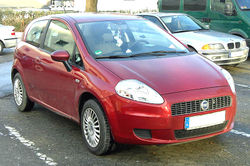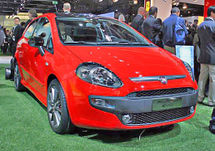Difference between revisions of "Fiat Punto"
m |
m |
||
| (26 intermediate revisions by the same user not shown) | |||
| Line 1: | Line 1: | ||
{{X}} | {{X}} | ||
| − | {| border=1 cellspacing=3 cellpadding=4 style="float:right; margin:0 0 .5em 1em; width: | + | {| border=1 cellspacing=3 cellpadding=4 style="float:right; margin:0 0 .5em 1em; width:280px; background:#505050; border-collapse:collapse; border:1px solid #999; font-size:83%; line-height:1.5; " summary="Infobox Automobile" |
|- style="text-align:center; background:#505050;" | |- style="text-align:center; background:#505050;" | ||
|- style="color:#fff; background:darkred; font-size:larger;" | |- style="color:#fff; background:darkred; font-size:larger;" | ||
| Line 17: | Line 17: | ||
|Successor:||Still in production | |Successor:||Still in production | ||
|- | |- | ||
| − | + | !colspan=2 style="color: white; background: darkred;"|[[Fiat Punto#Mark 1|Mark 1]] | |
|- | |- | ||
| − | !colspan=2 style="color: white; background: darkred;"|Mark 1 | + | |Production:||[[1994]]—[[1999]] |
| + | |- | ||
| + | !colspan=2 style="color: white; background: darkred;"|[[Fiat Punto#Mark 2 (1999-2003)|Mark 2]] | ||
| + | |- | ||
| + | |Production:||[[1999]]—[[2003]] | ||
| + | |- | ||
| + | !colspan=2 style="color: white; background: darkred;"|[[Fiat Punto#Mark 2, Revision B (2003-2005)|Mark 2b]] | ||
| + | |- | ||
| + | |Production:||[[2003]]—[[2005]] | ||
| + | |- | ||
| + | !colspan=2 style="color: white; background: darkred;"|[[Fiat Punto#Mark 3 'Grande Punto' (2005-present)|Mark 3]] | ||
| + | |- | ||
| + | |Production:||[[2005]]—present | ||
| + | |} | ||
| + | |||
| + | ==Mark 1 (1993-1999)== | ||
| + | {| border=1 cellspacing=3 cellpadding=4 style="float:right; margin:0 0 .5em 1em; width:280px; background:#505050; border-collapse:collapse; border:1px solid #999; font-size:83%; line-height:1.5; " summary="Infobox Automobile" | ||
| + | |- style="text-align:center; background:#505050;" | ||
| + | | colspan=2 style="padding:0; background:#505050; color:#fff; border-bottom:1px solid #999;" |[[File:Fiat Punto front 20071204.jpg|280px]]<br/>[[File:Fiat Punto rear 20071204.jpg|280px]] | ||
| + | |- style="color:#fff; background:darkred; font-size:larger;" | ||
| + | ! colspan=2 |'''Mark 1''' | ||
|- | |- | ||
| − | |Production | + | | Production || 1993–1999 |
| − | <!-- |- | + | |- |
| − | | | + | | Predecessor || Fiat Uno |
| + | |- | ||
| + | | Trim levels || 55,60,75, S, SX, ELX, Sporting, GT & Selecta | ||
| + | |- | ||
| + | | Body style || 3/5-door [[hatchback]]<br>3-door [[convertible]]<br>3-door [[van]] | ||
| + | |- | ||
| + | | Engine || 1.1 L [[straight-4|I4]]<br>1.2 L [[straight-4|I4]]<br>1.4 L [[straight-4|I4]] [[turbocharger|turbo]]<br>1.6 L [[straight-4|I4]]<br>1.7 L [[straight-4|I4]] [[Diesel engine|diesel]] | ||
| + | |- | ||
| + | | Transmission || 5-speed [[manual transmission|manual]]<br>6-speed [[manual transmission|manual]]<br>[[Continuously variable transmission|CVT]] | ||
| + | |- | ||
| + | | Wheelbase || 2450 mm | ||
| + | |- | ||
| + | | Length || 3760 mm | ||
| + | |- | ||
| + | | Width || 1625 mm | ||
| + | |- | ||
| + | | Height || 1450 mm | ||
| + | |- | ||
| + | | Weight || 830–1040 kg (1829–2292 lb)<br>1070 kg (2358 lb) ''cabrio'' | ||
| + | |- | ||
| + | | Fuel capacity || 47 L (10.3 [[Imperial unit|Imp. gallons]])<br />(12.4 [[United States customary units|U.S. gal]]) | ||
| + | |- | ||
| + | | Related || [[Fiat Palio]] | ||
| + | |- | ||
| + | | Designer || [[Giorgetto Giugiaro]] | ||
| + | |} | ||
| + | |||
| + | |||
| + | Internally codenamed ''Project 176'', the Punto was announced in September 1993 and launched in early 1994 as a replacement for the ageing [[Fiat Uno]]. The Fiat Punto was voted [[Car of the Year|European Car of the Year]] for 1995. The Punto's distinctive clean-cut styling by [[Giorgetto Giugiaro]] was an instant hit (though one of the car's most recognisable features, the vertical tail/rear lights, were not part of Giugiaro's original design and were in fact added later in-house at Fiat's factory). Competitive pricing which undercut rivals such as the [[Opel Corsa|Opel]]/[[Vauxhall Corsa]] and [[Volkswagen Polo]] also helped the Punto become an instant success in the European marketplace. | ||
| + | |||
| + | ===Entry level=== | ||
| + | Entry-level in the Punto range were the 1.1 and 1.2 L [[petrol engine]]s and the 1.7 [[diesel engine]]. The 1.2 engine's actual capacity is 1.242 litres, available in 3 versions. The first, was fitted in the Punto ELX 75 and produced 75 hp at 6000 rpm while the second, fitted to Punto ELX 85 produced 86 hp at 6000 rpm. The third was a 60 hp engine which eventually replaced the 1.1 54 hp engine. | ||
| + | |||
| + | ===Sporting versions=== | ||
| + | A 1.6 Sporting was also available producing 88 bhp (replaced in 1997 by the more economic 16 valve 1.2 unit), but the best performing version was the 136 PS 1.4 GT using an evolution of the turbocharged [[Fiat SOHC|128 SOHC engine]] originally found in the [[Fiat Uno]] Turbo Mk II- capable of running over 200 km/h and reaching 100 km/h in just 7.9 seconds. This car was also fitted with a 5-speed manual gearbox, with different gear ratios than the ELX series. During the years the GT was made in three different "series" with power 136 PS (1993-1995), 133 PS (1995-1997) and 130 PS (1997-1999). | ||
| + | |||
| + | ===Convertible=== | ||
| + | A [[convertible|cabriolet]] (convertible) version was also available; built by [[Bertone]] (rather than at the main Fiat factory), it featured an electric powered fully-retracting roof and was one of the cheapest open-top cars in the world at the time. Available in both ELX and SX trim, initially powered by the 90Bhp 1.6 Mpi unit (replaced in 1997 by the 86Bhp 1.2 16v FIRE unit). 55,000 cars were built between 1994-2000 | ||
| + | |||
| + | ===Other versions=== | ||
| + | Particular versions of the Mark I Punto were the Punto 6Speed, a 1.1 FIRE Punto 55 with a 6-speed gearbox, the Punto Selecta with a [[CVT]]-type automatic gearbox, and the Punto ED (Economical Drive), a 1.1 Punto whose 5-speed gearbox was designed for high fuel efficiency. | ||
| + | |||
| + | {{-}} | ||
| + | ==Mark 2 (1999-2003)== | ||
| + | {| border=1 cellspacing=3 cellpadding=4 style="float:right; margin:0 0 .5em 1em; width:280px; background:#505050; border-collapse:collapse; border:1px solid #999; font-size:83%; line-height:1.5; " summary="Infobox Automobile" | ||
| + | |- style="text-align:center; background:#505050;" | ||
| + | | colspan=2 style="padding:0; background:#505050; color:#fff; border-bottom:1px solid #999;" |[[File:Fiat Punto 2 front 20071006.jpg|280px|Fiat Punto Mk. 2]]<br/>[[File:Fiat Punto 2 rear 20071006.jpg|280px]] | ||
| + | |- style="color:#fff; background:darkred; font-size:larger;" | ||
| + | ! colspan=2 |'''Mark 2''' | ||
| + | |- | ||
| + | | Production || 1999–2003 | ||
| + | |- | ||
| + | | Body style || 3/5-door [[hatchback]] | ||
| + | |- | ||
| + | | Engine || 1.2 L 8v [[straight-4|I4]]<br>1.2 L 16v [[straight-4|I4]]<br>1.8 L 16v [[straight-4|I4]]<br>1.9 L [[straight-4|I4]] [[Diesel engine|diesel]] | ||
| + | |- | ||
| + | | Transmission || 5-speed [[manual transmission|manual]]<br>6-speed [[manual transmission|manual]] (Sporting)<br>6 or 7-speed [[Continuously variable transmission|CVT]]/[[semi-automatic transmission|semi-auto]] (Speedgear) | ||
| + | |- | ||
| + | | Wheelbase || 2460 mm | ||
| + | |- | ||
| + | | Length || 3800 mm | ||
| + | |- | ||
| + | | Width || 1660 mm | ||
| + | |- | ||
| + | | Height || 1480 mm | ||
| + | |- | ||
| + | | Weight || 860–1050 kg (1895–2314 lb) | ||
| + | |- | ||
| + | | Fuel capacity || 47 L (10.3 [[Imperial unit|Imp. gallons]])<br />(12.4 [[United States customary units|U.S. gal]]) | ||
| + | |- | ||
| + | | Related || [[Fiat Barchetta]]<br>[[Fiat Idea]]<br>[[Lancia Ypsilon]]<br>[[Lancia Musa]]<br>[[Zastava 10]] | ||
| + | |} | ||
| + | |||
| + | |||
| + | The second generation ''Nuova'' (New) Punto, codenamed ''Project 188'', was launched in 1999. The styling was all-new while retaining the original Punto's distinctive shape and design, while the chassis and interior were completely overhauled. The new Punto also became the first Fiat in decades to carry the original round Fiat badge, to celebrate Fiat's centenary. | ||
| + | |||
| + | ===Entry level=== | ||
| + | The 1.1 and 1.4 turbo engines were discontinued due to emissions issues, and the entry-level models had only a 1.2 petrol unit (with either 8 or 16 valves, giving 60 and 80 hp respectively) or a 1.9 diesel (with or without common-rail injection) | ||
| + | |||
| + | ===Sporting versions=== | ||
| + | Two sporty versions were offered. The 1.2 16 valve Sporting model with a 6-speed manual, and the hot 1.8 HGT which could reach almost 130 mi/h. The 1.2 16V model also has a CVT-equipped variant (with a sequential manual shift mode consisting of 6 gears, 7 for the Sporting model). The 1.8 HGT accelerates 0-60 in 8.0 seconds. It was considered a big improvement in handling over the Mark 1 GT. | ||
| + | |||
| + | ===Power steering=== | ||
| + | The Mark two [[Fiat]] Punto has also adopted Dualdrive electric [[power steering]] and comes with two operation modes, using an [[electric motor]], rather than a hydraulic pump driven by the engine. This results in reduced fuel consumption and less environmental impact. It has a fuel economy of 31.7 mpgimp - urban and 58.4 mpgimp - extra urban for the 1.7 diesel. The 1.8 petrol does 31.7 mpgimp - urban and 48.7 mpgimp - extra urban. | ||
| + | |||
| + | ===Punto Mk2 specifications=== | ||
| + | {| border=1 cellspacing=3 cellpadding=4 style="float:center; margin:0 0 .5em 1em; width:400px; background:#505050; border-collapse:collapse; border:1px solid #999; font-size:83%; line-height:1.5; " summary="Infobox Automobile" | ||
| + | |- style="text-align:center; background:#505050;" | ||
| + | |- tr BGCOLOR=darkred | ||
| + | |- | ||
| + | |'''Capacity''' | ||
| + | |1242–1910 cc | ||
| + | |- | ||
| + | |'''Power''' | ||
| + | | 60 PS - 130 PS | ||
|- | |- | ||
| − | | | + | |'''Max. speed''' |
| + | | 155 km/h - 205 km/h | ||
|- | |- | ||
| − | |colspan=2|[[ | + | |'''Acceleration''' |
| + | |0–100 km/h: 15.0–8.2 seconds | ||
| + | |} | ||
| + | |||
| + | {{-}} | ||
| + | |||
| + | ==Mark 2 (Facelift) (2003-2009)== | ||
| + | {| border=1 cellspacing=3 cellpadding=4 style="float:right; margin:0 0 .5em 1em; width:280px; background:#505050; border-collapse:collapse; border:1px solid #999; font-size:83%; line-height:1.5; " summary="Infobox Automobile" | ||
| + | |- style="text-align:center; background:#505050;" | ||
| + | | colspan=2 style="padding:0; background:#505050; color:#fff; border-bottom:1px solid #999;" |[[File:Fiat Punto front 20080714.jpg|280px|MK2b Punto]]<br/>[[File:Fiat Punto rear 20080714.jpg|280px]] | ||
| + | |- style="color:#fff; background:darkred; font-size:larger;" | ||
| + | ! colspan=2 |'''Mark 2 (Facelift)''' | ||
|- | |- | ||
| − | + | | Production || 2003-2009 | |
|- | |- | ||
| − | | | + | | Body style || 3/5-door [[hatchback]]<br>3-door [[van]] |
| − | |||
| − | |||
|- | |- | ||
| − | | | + | | Engine || 1.2 L 8v [[straight-4|I4]]<br>1.2 L 16v [[straight-4|I4]]<br>1.4 L 16v [[straight-4|I4]]<br>1.3 L [[straight-4|I4]] [[Diesel engine|diesel]]<br>1.8 L 16v [[straight-4|I4]]<br>1.9 L [[straight-4|I4]] [[Diesel engine|diesel]] |
|- | |- | ||
| − | + | | Transmission || 5-speed [[manual transmission|manual]]<br>6-speed [[semi-automatic transmission|semi-Auto]]<br>5-speed [[Electrohydraulic manual transmission|seq. manual]] (Dualogic) | |
|- | |- | ||
| − | | | + | | Wheelbase || 2460 mm |
| − | |||
| − | |||
|- | |- | ||
| − | | | + | | Length || 3800 mm |
|- | |- | ||
| − | | | + | | Width || 1660 mm |
|- | |- | ||
| − | + | | Height || 1480 mm | |
|- | |- | ||
| − | | | + | | Weight || 860–1050 kg (1895–2314 lb) |
| − | |||
| − | |||
|- | |- | ||
| − | | | + | | Aka || Fiat Punto Classic<br/>[[Zastava 10]] |
|- | |- | ||
| − | | | + | | Fuel economy || |
|- | |- | ||
| − | | | + | | Fuel capacity || 47 L (10.3 [[Imperial unit|Imp. gallons]])<br>(12.4 [[United States customary units|U.S. gal]]) |
|} | |} | ||
| − | + | In early 2003, Fiat celebrated the rollout of the 5,000,000th production Punto. In the same year, the Mark 2 Facelift brought further revisions to the platform, including extensive changes to the exterior styling and engines. | |
| + | The round Fiat badge, found only on the bonnet of Mark 2 models, was introduced on the tailgate of the Mark 2 Facelift. On [[June 1]] [[2005]], Fiat produced the 6,000,000th Punto at the Melfi plant. This Punto is currently the fourth-best selling [[supermini car|supermini]] in Europe. | ||
| − | ==Mark 1 | + | ===Engines=== |
| + | Engine changes included a new 1.4 16v engine, alongside the staple 1.2 & 1.2 16v variants, and the introduction of two HGT versions, 1.9 L ''Multijet'' [[diesel engine|diesel]] , and 1.8 L 16v petrol engine which could reach almost {{convert|130|mi/h|km/h|abbr=on}} continued over from the Mark 2. There was an introduction also of the 1.3 L [[common rail]] [[diesel engine|diesel]] ''MultiJet'' engine. | ||
| + | |||
| + | ===Punto Classic=== | ||
| + | Despite the launch of the slightly larger '''Grande Punto''' in 2005, the 1999 Punto is still in production, and was launched for the first time in [[Chile]] in 2007, as Punto Classic. It is to be replaced by a new B segment model. | ||
| − | + | ===Zastava 10=== | |
| + | ''Main article'' [[Zastava 10]] | ||
| − | + | In October 2005, [[Serbia]]n manufacturer [[Zastava]] reached an agreement with Fiat to make this version under licence with the model name '''Zastava 10'''. | |
| + | After acquiring [[Zastava]] in autumn 2008, Fiat continued production of this vehicle under the brandname Fiat Punto Classic in March, 2009. | ||
| − | == | + | ===Punto Mk2 Facelift specifications=== |
| − | + | {| border=1 cellspacing=3 cellpadding=4 style="float:center; margin:0 0 .5em 1em; width:400px; background:#505050; border-collapse:collapse; border:1px solid #999; font-size:83%; line-height:1.5; " summary="Infobox Automobile" | |
| + | |- style="text-align:center; background:#505050;" | ||
| + | |- tr BGCOLOR=darkred | ||
| + | |- | ||
| + | |'''Capacity''' | ||
| + | |1242–1910 cc | ||
| + | |- | ||
| + | |'''Power''' | ||
| + | | 60 PS - 130 PS | ||
| + | |- | ||
| + | |'''Max. speed''' | ||
| + | | 155 km/h - 205 km/h | ||
| + | |- | ||
| + | |'''Acceleration''' | ||
| + | |0–100 km/h: 14.3–8.6 seconds | ||
| + | |} | ||
| − | + | {{-}} | |
| Line 84: | Line 226: | ||
| − | ==Mark 3 (2005-)== | + | ==Mark 3 'Grande Punto' (2005-present) == |
| + | ''Main article'' [[Fiat Grande Punto]] | ||
| − | The third | + | [[File:Fiat Grande Punto front.JPG|250px|thumb|right|Grande Punto]] |
| + | The third Fiat car, codenamed ''Project 199'', and marketed as ''[[Fiat Grande Punto|Grande Punto]]'', was unveiled at the 2005 [[Internationale Automobil-Ausstellung|Frankfurt Motor Show]] and went on sale later on that year. Again styled by Giugiaro, the car is using the [[GM Gamma platform#SCCS|Fiat/GM SCCS platform]]. | ||
The engines are the 1.2 Fire 8v, a new 1.4 Fire 8v and four Multijet Diesel: two 1.3 16v units (one with a geometric variable turbo 90bhp) and two 1.9 JTD Multijets with 120 and 130cv. The top-of-the-range GT version will be powered by a turbocharged 1.6 engine developing 180-200bhp. | The engines are the 1.2 Fire 8v, a new 1.4 Fire 8v and four Multijet Diesel: two 1.3 16v units (one with a geometric variable turbo 90bhp) and two 1.9 JTD Multijets with 120 and 130cv. The top-of-the-range GT version will be powered by a turbocharged 1.6 engine developing 180-200bhp. | ||
| + | {{-}} | ||
| + | ==Mark 3 facelift 'Punto Evo' (2009-present) == | ||
| + | [[File:Fiat Punto Evo.jpg|215px|thumb|left|Punto Evo]] | ||
| + | This model is on the market [[Italy]] since 10th October 2009 and then spread over the world. Preview is [http://www.puntoevo.it/ PuntoEvo] | ||
| + | |||
| + | This is a link to a test promotion : http://staging.complete-your-download.de/Bridge.aspx?t=technologie&c=111 | ||
| + | |||
| + | {{-}} | ||
| + | ==Punto Van== | ||
| + | The '''Punto Van''' is a compact van that is used in a commercial environment. It is built also with a diesel 1.3 [[MultiJet|Multijet]] 16 commercial model. | ||
==Punto in motorsport== | ==Punto in motorsport== | ||
| + | {| border=1 cellspacing=3 cellpadding=4 style="float:right; margin:0 0 .5em 1em; width:300px; background:#505050; border-collapse:collapse; border:1px solid #999; font-size:83%; line-height:1.5; " summary="Infobox Automobile" | ||
| + | |- style="text-align:center; background:#505050;" | ||
| + | | colspan=2 style="padding:0; background:#808080; color:#fff; border-bottom:1px solid #999;" |<videoflash>f3kvdIGyXmE|300|200</videoflash> | ||
| + | |- style="color:#fff; background:darkred; font-size:larger;" | ||
| + | ! colspan=2 |'''Fiat Punto Abarth''' | ||
| + | |} | ||
| + | |||
| + | [[Image:FiatPuntoRacer.jpg|thumb|left|250px|Punto [[Abarth]]]] | ||
| + | The Punto has always been popular with amateur [[auto racing|racing drivers]] due to its low cost and the wide availability of spare parts. Several competition and [[homologation|homologated]] versions of the Punto have been produced, such as the Punto Rally, the S1600 and the Punto [[Abarth]]. A new rally car based on the third generation Punto, the Super 2000 Punto [[Abarth]], was unveiled in 2005. It is [[four-wheel drive]] and powered by a 2.0 L 16 valve engine capable of producing 280 hp. | ||
| + | |||
| + | Punto has competed in the following motorsport events; | ||
| + | * Targa Tasmania, Showroom class, (2007) the first diesel car to compete. | ||
| − | + | Punto won several rally championships, especially: | |
| − | + | *Italian rally championship (2003 and 2006) | |
| + | *European rally championship (2006) | ||
| + | *International rally challenge (2006) | ||
| + | A motorsport version of the car can be found in several liveries in the video games [[Colin McRae Rally 04]], [[Colin McRae: DiRT]] and [[Sega Rally Revo]].{{-}} | ||
Latest revision as of 11:50, 1 November 2009
| Fiat Punto | |
|---|---|
| Manufacturer: | Fiat |
| Production: | 1993 — present |
| Layout & Class: | FF supermini |
| Body Styles: | 3 and 5-door hatchback 3-door convertible (Mark 1 only) |
| Predecessor: | Fiat Uno |
| Successor: | Still in production |
| Mark 1 | |
| Production: | 1994—1999 |
| Mark 2 | |
| Production: | 1999—2003 |
| Mark 2b | |
| Production: | 2003—2005 |
| Mark 3 | |
| Production: | 2005—present |
Mark 1 (1993-1999)
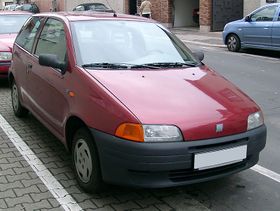 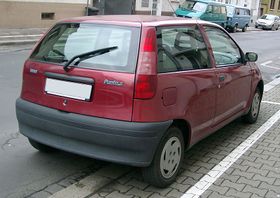
| |
| Mark 1 | |
|---|---|
| Production | 1993–1999 |
| Predecessor | Fiat Uno |
| Trim levels | 55,60,75, S, SX, ELX, Sporting, GT & Selecta |
| Body style | 3/5-door hatchback 3-door convertible 3-door van |
| Engine | 1.1 L I4 1.2 L I4 1.4 L I4 turbo 1.6 L I4 1.7 L I4 diesel |
| Transmission | 5-speed manual 6-speed manual CVT |
| Wheelbase | 2450 mm |
| Length | 3760 mm |
| Width | 1625 mm |
| Height | 1450 mm |
| Weight | 830–1040 kg (1829–2292 lb) 1070 kg (2358 lb) cabrio |
| Fuel capacity | 47 L (10.3 Imp. gallons) (12.4 U.S. gal) |
| Related | Fiat Palio |
| Designer | Giorgetto Giugiaro |
Internally codenamed Project 176, the Punto was announced in September 1993 and launched in early 1994 as a replacement for the ageing Fiat Uno. The Fiat Punto was voted European Car of the Year for 1995. The Punto's distinctive clean-cut styling by Giorgetto Giugiaro was an instant hit (though one of the car's most recognisable features, the vertical tail/rear lights, were not part of Giugiaro's original design and were in fact added later in-house at Fiat's factory). Competitive pricing which undercut rivals such as the Opel/Vauxhall Corsa and Volkswagen Polo also helped the Punto become an instant success in the European marketplace.
Entry level
Entry-level in the Punto range were the 1.1 and 1.2 L petrol engines and the 1.7 diesel engine. The 1.2 engine's actual capacity is 1.242 litres, available in 3 versions. The first, was fitted in the Punto ELX 75 and produced 75 hp at 6000 rpm while the second, fitted to Punto ELX 85 produced 86 hp at 6000 rpm. The third was a 60 hp engine which eventually replaced the 1.1 54 hp engine.
Sporting versions
A 1.6 Sporting was also available producing 88 bhp (replaced in 1997 by the more economic 16 valve 1.2 unit), but the best performing version was the 136 PS 1.4 GT using an evolution of the turbocharged 128 SOHC engine originally found in the Fiat Uno Turbo Mk II- capable of running over 200 km/h and reaching 100 km/h in just 7.9 seconds. This car was also fitted with a 5-speed manual gearbox, with different gear ratios than the ELX series. During the years the GT was made in three different "series" with power 136 PS (1993-1995), 133 PS (1995-1997) and 130 PS (1997-1999).
Convertible
A cabriolet (convertible) version was also available; built by Bertone (rather than at the main Fiat factory), it featured an electric powered fully-retracting roof and was one of the cheapest open-top cars in the world at the time. Available in both ELX and SX trim, initially powered by the 90Bhp 1.6 Mpi unit (replaced in 1997 by the 86Bhp 1.2 16v FIRE unit). 55,000 cars were built between 1994-2000
Other versions
Particular versions of the Mark I Punto were the Punto 6Speed, a 1.1 FIRE Punto 55 with a 6-speed gearbox, the Punto Selecta with a CVT-type automatic gearbox, and the Punto ED (Economical Drive), a 1.1 Punto whose 5-speed gearbox was designed for high fuel efficiency.
Mark 2 (1999-2003)
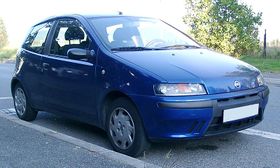 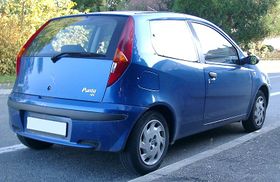
| |
| Mark 2 | |
|---|---|
| Production | 1999–2003 |
| Body style | 3/5-door hatchback |
| Engine | 1.2 L 8v I4 1.2 L 16v I4 1.8 L 16v I4 1.9 L I4 diesel |
| Transmission | 5-speed manual 6-speed manual (Sporting) 6 or 7-speed CVT/semi-auto (Speedgear) |
| Wheelbase | 2460 mm |
| Length | 3800 mm |
| Width | 1660 mm |
| Height | 1480 mm |
| Weight | 860–1050 kg (1895–2314 lb) |
| Fuel capacity | 47 L (10.3 Imp. gallons) (12.4 U.S. gal) |
| Related | Fiat Barchetta Fiat Idea Lancia Ypsilon Lancia Musa Zastava 10 |
The second generation Nuova (New) Punto, codenamed Project 188, was launched in 1999. The styling was all-new while retaining the original Punto's distinctive shape and design, while the chassis and interior were completely overhauled. The new Punto also became the first Fiat in decades to carry the original round Fiat badge, to celebrate Fiat's centenary.
Entry level
The 1.1 and 1.4 turbo engines were discontinued due to emissions issues, and the entry-level models had only a 1.2 petrol unit (with either 8 or 16 valves, giving 60 and 80 hp respectively) or a 1.9 diesel (with or without common-rail injection)
Sporting versions
Two sporty versions were offered. The 1.2 16 valve Sporting model with a 6-speed manual, and the hot 1.8 HGT which could reach almost 130 mi/h. The 1.2 16V model also has a CVT-equipped variant (with a sequential manual shift mode consisting of 6 gears, 7 for the Sporting model). The 1.8 HGT accelerates 0-60 in 8.0 seconds. It was considered a big improvement in handling over the Mark 1 GT.
Power steering
The Mark two Fiat Punto has also adopted Dualdrive electric power steering and comes with two operation modes, using an electric motor, rather than a hydraulic pump driven by the engine. This results in reduced fuel consumption and less environmental impact. It has a fuel economy of 31.7 mpgimp - urban and 58.4 mpgimp - extra urban for the 1.7 diesel. The 1.8 petrol does 31.7 mpgimp - urban and 48.7 mpgimp - extra urban.
Punto Mk2 specifications
| Capacity | 1242–1910 cc |
| Power | 60 PS - 130 PS |
| Max. speed | 155 km/h - 205 km/h |
| Acceleration | 0–100 km/h: 15.0–8.2 seconds |
Mark 2 (Facelift) (2003-2009)
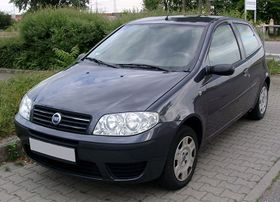 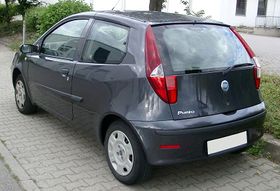
| |
| Mark 2 (Facelift) | |
|---|---|
| Production | 2003-2009 |
| Body style | 3/5-door hatchback 3-door van |
| Engine | 1.2 L 8v I4 1.2 L 16v I4 1.4 L 16v I4 1.3 L I4 diesel 1.8 L 16v I4 1.9 L I4 diesel |
| Transmission | 5-speed manual 6-speed semi-Auto 5-speed seq. manual (Dualogic) |
| Wheelbase | 2460 mm |
| Length | 3800 mm |
| Width | 1660 mm |
| Height | 1480 mm |
| Weight | 860–1050 kg (1895–2314 lb) |
| Aka | Fiat Punto Classic Zastava 10 |
| Fuel economy | |
| Fuel capacity | 47 L (10.3 Imp. gallons) (12.4 U.S. gal) |
In early 2003, Fiat celebrated the rollout of the 5,000,000th production Punto. In the same year, the Mark 2 Facelift brought further revisions to the platform, including extensive changes to the exterior styling and engines.
The round Fiat badge, found only on the bonnet of Mark 2 models, was introduced on the tailgate of the Mark 2 Facelift. On June 1 2005, Fiat produced the 6,000,000th Punto at the Melfi plant. This Punto is currently the fourth-best selling supermini in Europe.
Engines
Engine changes included a new 1.4 16v engine, alongside the staple 1.2 & 1.2 16v variants, and the introduction of two HGT versions, 1.9 L Multijet diesel , and 1.8 L 16v petrol engine which could reach almost Template:Convert/mi/hTemplate:Convert/test/Aon continued over from the Mark 2. There was an introduction also of the 1.3 L common rail diesel MultiJet engine.
Punto Classic
Despite the launch of the slightly larger Grande Punto in 2005, the 1999 Punto is still in production, and was launched for the first time in Chile in 2007, as Punto Classic. It is to be replaced by a new B segment model.
Zastava 10
Main article Zastava 10
In October 2005, Serbian manufacturer Zastava reached an agreement with Fiat to make this version under licence with the model name Zastava 10.
After acquiring Zastava in autumn 2008, Fiat continued production of this vehicle under the brandname Fiat Punto Classic in March, 2009.
Punto Mk2 Facelift specifications
| Capacity | 1242–1910 cc |
| Power | 60 PS - 130 PS |
| Max. speed | 155 km/h - 205 km/h |
| Acceleration | 0–100 km/h: 14.3–8.6 seconds |
Mark 2, Revision B (2003-2005)
In early 2003, Fiat celebrated the rollout of the 5,000,000th production Punto. In the same year, the Mark 2 revision B revamp brought further revisions to the platform, including extensive changes to the exterior styling and the dropping of the 1.2 litre Sporting in favour of a new 1.4 16v engine, and the introduction of the 1.3 litre common rail diesel MultiJet engine. The round Fiat badge, found only on the bonnet of Mark 2 models, was introduced on the tailgate of the Mark 2B. On 1 June 2005, Fiat produced the 6,000,000th Punto at the Melfi plant. This Punto is currently the fourth-best selling subcompact (i.e., Class-B) car in Europe.
In October 2005, Serbian manufacturer Zastava reached an agreement with Fiat to make this version under licence with the model name Zastava 10.
Mark 3 'Grande Punto' (2005-present)
Main article Fiat Grande Punto
The third Fiat car, codenamed Project 199, and marketed as Grande Punto, was unveiled at the 2005 Frankfurt Motor Show and went on sale later on that year. Again styled by Giugiaro, the car is using the Fiat/GM SCCS platform.
The engines are the 1.2 Fire 8v, a new 1.4 Fire 8v and four Multijet Diesel: two 1.3 16v units (one with a geometric variable turbo 90bhp) and two 1.9 JTD Multijets with 120 and 130cv. The top-of-the-range GT version will be powered by a turbocharged 1.6 engine developing 180-200bhp.
Mark 3 facelift 'Punto Evo' (2009-present)
This model is on the market Italy since 10th October 2009 and then spread over the world. Preview is PuntoEvo
This is a link to a test promotion : http://staging.complete-your-download.de/Bridge.aspx?t=technologie&c=111
Punto Van
The Punto Van is a compact van that is used in a commercial environment. It is built also with a diesel 1.3 Multijet 16 commercial model.
Punto in motorsport
| Fiat Punto Abarth |
|---|
The Punto has always been popular with amateur racing drivers due to its low cost and the wide availability of spare parts. Several competition and homologated versions of the Punto have been produced, such as the Punto Rally, the S1600 and the Punto Abarth. A new rally car based on the third generation Punto, the Super 2000 Punto Abarth, was unveiled in 2005. It is four-wheel drive and powered by a 2.0 L 16 valve engine capable of producing 280 hp.
Punto has competed in the following motorsport events;
- Targa Tasmania, Showroom class, (2007) the first diesel car to compete.
Punto won several rally championships, especially:
- Italian rally championship (2003 and 2006)
- European rally championship (2006)
- International rally challenge (2006)
A motorsport version of the car can be found in several liveries in the video games Colin McRae Rally 04, Colin McRae: DiRT and Sega Rally Revo.
External links
| <- Older Models | Fiat car timeline, European market, 1980s - present | |||||||||||||||||||||||||||||||||||||||
| Type | 1980s | 1990s | 2000s | 2010s | ||||||||||||||||||||||||||||||||||||
| 0 | 1 | 2 | 3 | 4 | 5 | 6 | 7 | 8 | 9 | 0 | 1 | 2 | 3 | 4 | 5 | 6 | 7 | 8 | 9 | 0 | 1 | 2 | 3 | 4 | 5 | 6 | 7 | 8 | 9 | 0 | 1 | 2 | 3 | 4 | 5 | |||||
| City cars | 126 | Cinquecento | Seicento (1998-2005) / 600 (2005-2010) | |||||||||||||||||||||||||||||||||||||
| 500 | ||||||||||||||||||||||||||||||||||||||||
| Panda I | Panda II | |||||||||||||||||||||||||||||||||||||||
| Supermini | 127 | Uno | Punto I | Punto II | ||||||||||||||||||||||||||||||||||||
| Grande Punto | Punto Evo | |||||||||||||||||||||||||||||||||||||||
| Small family car |
Ritmo | Tipo | Bravo / Brava | Stilo | Bravo II | |||||||||||||||||||||||||||||||||||
| 131 | Regata | Tempra | Marea | Linea | ||||||||||||||||||||||||||||||||||||
| Albea | ||||||||||||||||||||||||||||||||||||||||
| Large family car | 132 | Argenta | Croma I | Croma II | ||||||||||||||||||||||||||||||||||||
| Coupé | Coupé | |||||||||||||||||||||||||||||||||||||||
| Roadster | 124 Spider | Barchetta | Barchetta | |||||||||||||||||||||||||||||||||||||
| Sports car | X1/9 | |||||||||||||||||||||||||||||||||||||||
| Panel van/Leisure activity vehicle | Fiorino I | Fiorino II | Fiorino III | |||||||||||||||||||||||||||||||||||||
| Doblò | ||||||||||||||||||||||||||||||||||||||||
| Mini SUV | Sedici | |||||||||||||||||||||||||||||||||||||||
| Mini MPV | Idea | |||||||||||||||||||||||||||||||||||||||
| Compact MPV | Multipla | |||||||||||||||||||||||||||||||||||||||
| Large MPV | Ulysse I | Ulysse II | ||||||||||||||||||||||||||||||||||||||
| Van | Daily* | Scudo I | Scudo II | |||||||||||||||||||||||||||||||||||||
| Ducato I | Ducato II | Ducato III | ||||||||||||||||||||||||||||||||||||||
| Mini Pickup | Strada | |||||||||||||||||||||||||||||||||||||||
| Off-road | Campagnola (1107) | |||||||||||||||||||||||||||||||||||||||
| *Rebadged Iveco model | ||||||||||||||||||||||||||||||||||||||||
